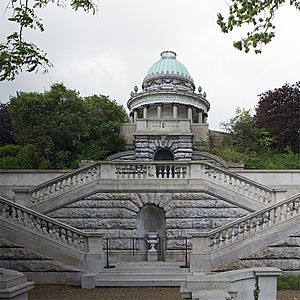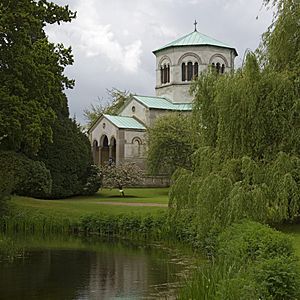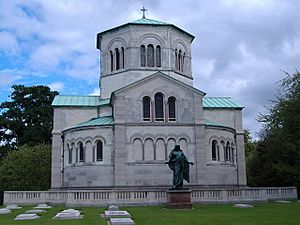Frogmore facts for kids
The Frogmore Estate or Gardens is a beautiful private garden area. It covers about 33 acres (13 hectares) and is located inside Home Park, Windsor, right next to Windsor Castle in Berkshire, England.
This special place is home to Frogmore House, which is a royal retreat, and Frogmore Cottage. The name "Frogmore" comes from the many frogs that have always lived in this low, wet area near the River Thames. It's part of the local flood plain.
Frogmore is also where several members of the British Royal Family are buried. These include the Royal Mausoleum, which holds the tombs of Queen Victoria and Prince Albert. There's also the Duchess of Kent's Mausoleum, where Queen Victoria's mother rests. Finally, the Royal Burial Ground is here too. The gardens themselves are very important and are listed as Grade I on the Register of Historic Parks and Gardens.
Contents
Frogmore House: A Royal Retreat
Frogmore House was built in the 1680s. In 1792, Queen Charlotte bought the lease for the house. She hired a famous architect named James Wyatt to make the house bigger and more modern for her.
In 1900, Prince Louis of Battenberg was born at Frogmore House.
Near the main house, you'll find Frogmore Cottage. This smaller building was also built for Queen Charlotte around 1801.
Royal Burial Places at Frogmore
Frogmore is a very important place for the Royal Family because it holds several burial sites.
Duchess of Kent's Mausoleum: A Mother's Resting Place
The first of two mausoleums (special burial buildings) in Frogmore Gardens belongs to Victoria of Saxe-Coburg-Saalfeld. She was the Duchess of Kent and Queen Victoria's mother.
The architect A J Humbert designed this mausoleum. He used an idea from Professor Ludwig Gruner, who was Prince Albert's favorite artist.
In her later years, the Duchess lived at Frogmore House. In the 1850s, work began on a beautiful domed "temple" in the estate grounds. The top part was meant to be a summer-house for the Duchess while she was alive. The lower level was planned as her final resting place.
Sadly, the Duchess died at Frogmore House on March 16, 1861. This happened before the summer-house was finished. So, the upper room became part of the mausoleum. It now holds a statue of the Duchess made by William Theed in 1864.
Royal Mausoleum: Queen Victoria and Prince Albert's Tomb
The second and much larger mausoleum at Frogmore is called the Royal Mausoleum. It is the burial place of Queen Victoria and her husband, Prince Albert. It's just a short walk from the Duchess of Kent's Mausoleum.
Queen Victoria and Prince Albert had always wanted a special resting place for themselves. They did not want to be buried in traditional royal sites like Westminster Abbey or St. George's Chapel at Windsor.
Prince Albert died in December 1861, while the mausoleum for the Queen's mother was still being built. Within days of his death, plans for the Royal Mausoleum were drawn up. The same designers, Professor Gruner and A. J. Humbert, worked on it.
Construction started in March 1862. The dome was finished by October, and the building was blessed in December 1862. However, the beautiful decorations inside were not completed until August 1871.
The building is shaped like a Greek cross. Its outside look was inspired by old Italian buildings. The walls are made of granite and Portland stone, and the roof is covered with copper from Australia. The inside is decorated in the style of Raphael, who was Albert's favorite painter. It shows off the rich style of the Victorian age. The inside walls are mostly made of red marble from Portugal. This marble was a gift from King Luis I of Portugal, who was a cousin to both Victoria and Albert. Other marbles from around the world are also used.
The main tomb was designed by Baron Carlo Marochetti. It features marble statues of the Queen and Prince Albert lying down. The sarcophagus was carved from a single, perfect piece of grey Aberdeen granite. Queen Victoria's statue was made at the same time. However, it was only placed in the mausoleum after her own funeral.
Only Victoria and Albert are buried here. But the mausoleum also has other memorials. One is for Princess Alice, Grand Duchess of Hesse-Darmstadt. She was Victoria's second daughter and died in 1878 from diphtheria. In the middle of the chapel is a memorial to Edward, Duke of Kent, Victoria's father. He died in 1820 and is buried at St George's Chapel, Windsor.
One special sculpture shows Queen Victoria and Prince Albert in Saxon clothes. Queen Victoria ordered this after Prince Albert died. It was made by William Theed and first shown in 1867 at Windsor Castle. In 1938, it was moved to the Royal Mausoleum.
The building has been closed to visitors since 2007. This is because its foundations are wet, and parts of the building are falling apart. In February 2018, the Royal Household announced that repair work would begin. The work is expected to finish by 2023.
Repairs started in June 2018. A deep trench was dug around the building to create a dry area. This helps the stone dry out. The leaky roof, drainpipes, and windows will also be fixed or replaced before the inside of the building is restored.
Royal Burial Ground: A Cemetery for Royals
Since it opened in 1928, most members of the royal family (except for Kings and Queens) have been buried in the Royal Burial Ground. This cemetery is located behind Queen Victoria's mausoleum.
Some of the people buried here include Prince Arthur, Duke of Connaught, and Prince Henry, Duke of Gloucester. Also here are Prince George, Duke of Kent, and the Duke of Windsor (who was King Edward VIII before he gave up the throne) and his wife Wallis. Many members of the families of Prince Christian of Schleswig-Holstein and the Marquess of Cambridge are also buried here.
The Burial Ground also had a cenotaph (a monument for someone buried elsewhere) for Queen Maria of Yugoslavia. She was a great-granddaughter of Queen Victoria and the wife of King Aleksandar I of Yugoslavia. She lived in London as an exile and was buried here from 1961 until April 2013. Then, her remains were moved back to Oplenac, Serbia.
Other Interesting Garden Features
The Frogmore grounds also have other interesting buildings and monuments:
- The 'Gothic Ruin' (built in 1793)
- 'Queen Victoria's Tea House' (a brick building from 1869)

To the southeast of Frogmore Cottage, there is an Indian kiosk. This beautiful marble structure was brought from the Qaisar Bagh in Lucknow. It was taken by the Viceroy of India, Charles Canning, 1st Earl Canning, in 1858. The kiosk has eight sides, an onion dome, round arches, and deep eaves. It is also a listed building, meaning it's historically important.
Visiting Frogmore Estate
The house and gardens are usually open to the public for about six days each year. These days are often around Easter and the August Bank Holiday.
You can view the Royal Burial Ground from its edges when the gardens are open. The Duchess of Kent's mausoleum can also be seen from the outside, but it is never open for visitors to go inside.
Images for kids
-
The Gothic Ruin by James Wyatt
See also
 In Spanish: Frogmore para niños
In Spanish: Frogmore para niños









